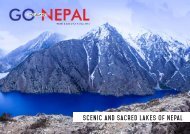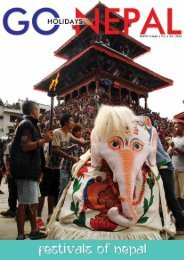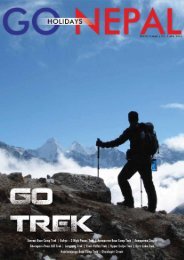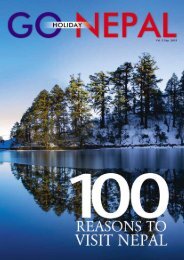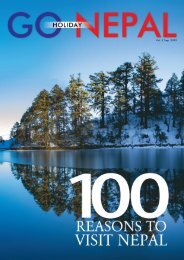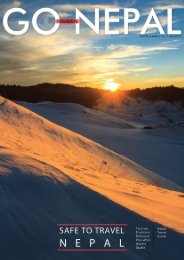Go Nepal e-Magazine
Go Nepal Holiday
Go Nepal Holiday
Create successful ePaper yourself
Turn your PDF publications into a flip-book with our unique Google optimized e-Paper software.
areas and there was damage in the Everest region<br />
again.<br />
Officials said a small glacial pond near Mount Everest<br />
burst its containment on Monday night, causing<br />
panic among villagers because they fear the<br />
earthquake and aftershocks may have destabilized<br />
bigger glacial lakes in the region.<br />
Geologists say the quakes triggered more than<br />
3,000 landslides in the affected areas and the upcoming<br />
monsoon could worsen conditions.<br />
“The reason why the mountains remain unstable<br />
is that earthquakes cause intense shaking of the<br />
landscape, which damages the rock and soils on<br />
hillsides,” says Prof Alex Densmore from the Institute<br />
of Hazard, Risk and Resilience at Durham<br />
University in the UK.<br />
“This means that even hillsides that did not fail<br />
during the earthquake are more damaged, and<br />
thus more prone to failure, than they were before<br />
25 April.<br />
“In some cases this damage may be visible at the<br />
surface in the form of cracks or fractures in the<br />
ground, but this is not necessarily the case; the<br />
damage may be at depth and not immediately visible.”<br />
Prof Jeffrey Kargel, a glaciologist at the University<br />
of Arizona who has studied landslides on <strong>Nepal</strong>ese<br />
mountains and their impacts on rivers, says an<br />
assessment of the situation is absolutely critical.<br />
“We have seen so much activity of the earth following<br />
the main shock and the largest aftershock<br />
that we have to presume that there is going to be<br />
a state of greatly heightened activity during this<br />
monsoon, and quite possibly into coming years,”<br />
he said.<br />
“It’s very clear that we have to do what’s possible,<br />
not just to keep trekkers and climbers safe, but<br />
also the people who service the trekkers and climbers<br />
and the entire economic structure of these very<br />
hard-hit areas.”<br />
But given <strong>Nepal</strong>’s difficult topography in the<br />
Himalayan region, assessing the risks would not be<br />
easy.<br />
“It will take quite a bit of work because every<br />
valley, every glacier, every mountain is going to be<br />
different depending on the circumstances of the<br />
glaciers, the moraines and possible fracturing of<br />
the rocks,” Prof Kargel said.<br />
International tour operators are waiting and<br />
watching as well.<br />
“To rush out and simply say it’s safe to come to<br />
<strong>Nepal</strong> without factual knowledge is a little bit foolhardy,<br />
potentially,” said Nicholas Cowlie, <strong>Nepal</strong><br />
general manager for Intrepid Travel - the largest<br />
international provider of trekking tourists to the<br />
country.<br />
“At this point, our clients are holding on to their<br />
(<strong>Nepal</strong>) holiday bookings and our major focus is<br />
to report back to them and show them that we are<br />
ready for business when we know that it is operationally<br />
safe.” (BBC World Service)




